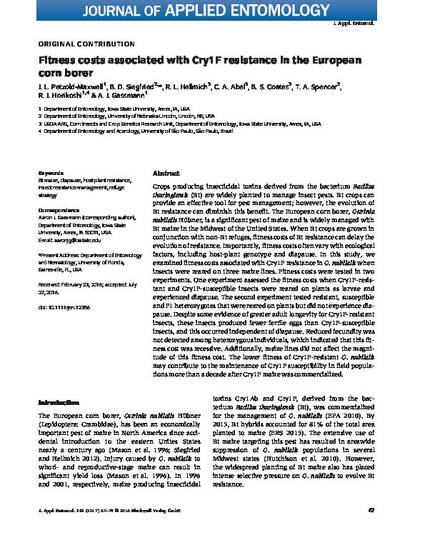
Crops producing insecticidal toxins derived from the bacterium Bacillus thuringiensis (Bt) are widely planted to manage insect pests. Bt crops can provide an effective tool for pest management; however, the evolution of Bt resistance can diminish this benefit. The European corn borer, Ostrinia nubilalis Hübner, is a significant pest of maize and is widely managed with Bt maize in the Midwest of the United States. When Bt crops are grown in conjunction with non-Bt refuges, fitness costs of Bt resistance can delay the evolution of resistance. Importantly, fitness costs often vary with ecological factors, including host-plant genotype and diapause. In this study, we examined fitness costs associated with Cry1F resistance in O. nubilaliswhen insects were reared on three maize lines. Fitness costs were tested in two experiments. One experiment assessed the fitness costs when Cry1F-resistant and Cry1F-susceptible insects were reared on plants as larvae and experienced diapause. The second experiment tested resistant, susceptible and F1 heterozygotes that were reared on plants but did not experience diapause. Despite some evidence of greater adult longevity for Cry1F-resistant insects, these insects produced fewer fertile eggs than Cry1F-susceptible insects, and this occurred independent of diapause. Reduced fecundity was not detected among heterozygous individuals, which indicated that this fitness cost was recessive. Additionally, maize lines did not affect the magnitude of this fitness cost. The lower fitness of Cry1F-resistant O. nubilalis may contribute to the maintenance of Cry1F susceptibility in field populations more than a decade after Cry1F maize was commercialized.
Available at: http://works.bepress.com/aaron_gassmann/71/

This article is published as Petzold‐Maxwell, J. L., Blair D. Siegfried, R. L. Hellmich, C. A. Abel, B. S. Coates, Terrence A. Spencer, R. J. Horikoshi, and Aaron J. Gassmann. "Fitness costs associated with Cry1F resistance in the European corn borer." Journal of Applied Entomology 141, no. 1-2 (2017): 67-79. doi: 10.1111/jen.12356. Posted with permission.